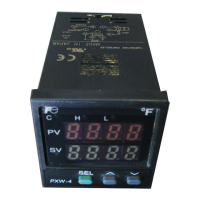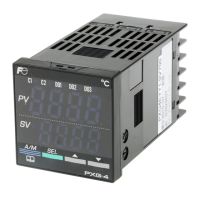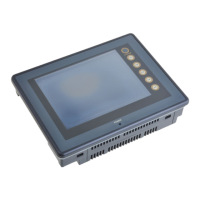14
sion resistor. Wired directly to the controller, it would
convert a current signal into a voltage signal. There is
no need to use the resistor if a voltage signal is
applied directly.
After the appropriate physical changes have been
made, the controller still needs the correct code for
the Input Type to be used. Enter the appropriate code
from the Table of Input Type Codes.
P-SL Lower Limit of Input Range: The Lower Limit of Input
Range is that value which establishes the desired low
limit for the type of input used. The value must be
greater than or equal to the input type’s lowest limit.
Setpoint settings are restricted to values greater than
the low limit. Parameters which are calculated as a
percentage of full scale are affected by this setting.
An underscale error message is indicated on the
process variable display when the process variable
goes below the Lower Limit of Input Range setting by
5% of full scale. The primary purpose of the Lower
Limit of Input Range when used with a thermocouple
or RTD sensor input is to limit setpoint settings.
Making the input range smaller does not increase the
accuracy. The primary purpose of the Lower Limit of
Input range when used with 1-5/0-5V DC or 4-20/0-
20mA DC signal input is to scale the range so that 1/0V
DC on a 1-5/0-5V DC signal and 4/0mA DC on a 4-20/0-
20mA DC signal equals the low limit of the engineering
unit range used. The engineering unit range could be
%, PSI, GPM, PH, or any range which can be scaled
between -1999 and 9999 units.
Enter a value to set Lower Limit of Input range based
on the type of input used.
P-SU Upper Limit of Input Range: The Upper Limit of Input
Range is that value which establishes the desired high
limit for the type of input used. The value must be less
than or equal to the input type’s highest limit. Setpoint
settings are restricted to values less than the high
limit. Parameters which are calculated as a percent-
age of full scale are affected by this setting. An over-
scale error message is indicated on the process vari-
able display when the process variable goes above
the Upper Limit of Input Range setting by 5% of full
scale. The primary purpose of the upper limit when
used with a thermocouple or RTD input is to limit set-
point settings. Making the input range smaller does
not increase the accuracy. The primary purpose of the
Upper Limit of Input range when used with 1-5/0-5V DC
or 4-20/0-20mA DC signal input is to scale the range so
that 5V DC on a 1-5/0-5VDC signal and 20mA DC on a
4-20/0-20mA DC signal equals the high limit of the
engineering unit range used. The engineering unit
range could be %, PSI, PH, or any range which can be
scaled between -1999 and 9999 units.
Enter a value to set Upper Limit of Input range based
on the type of input used.
P-dP Decimal Point Position (Resolution): The Decimal
Point
Position is the resolution at which the controller
displays the process variable and other parameter val-
ues. The display can indicate integers, tenths or hun-
dredths of a unit. The Decimal Point Position does not
increase the accuracy of the controller, it only increases
the resolution. For a thermocouple, integers are usually
sufficient due to the accuracy rating and the pro-
grammed input range. For a RTD (Pt100), integers or
tenths of a degree may be entered, because of the
increased accuracy of these sensors, depending on the
programmed input range. For a 1-5/0-5V DC or 4-20/0-
20mA DC signal, integers, tenths or hundredths of a unit
may be entered depending on the programmed input
range.
Setting:
0 -None
1- Tenths of a unit
2 - Hundredths of a unit

